- Home
- Before you incubate
- Transporting eggs
Transporting fertile chicken eggs by plane: is it possible?
Are fertile eggs for hatching allowed on planes?
Here are the facts, the risks and how best to carry them to make sure they arrive safely home.
You'll find a lot of information on the internet about transporting fertile chicken eggs. Much of it is misleading and most of it is simply wrong.
The information on this page is based on my personal experience, on information from the reliable sources and advice from security staff at Stansted airport, London, England.
Note: although these are the facts, security at airports can vary. It's always wise to check with your local airport before you take or send hatching eggs by air.
Firstly: is it legal?
Most of the reliable information about transporting hatching eggs by plane relates to commercial, not backyard, production (see for example Sources 1 - 5).
These are the regulations regarding transporting fertile hatching eggs for backyard flocks by air.
- Within EU countries, it is perfectly legal.
- Within the United States, it is perfectly legal.
Importing from any countries outside the EU, including the UK post-Brexit, chicks must be isolated after hatch:
"Poultry and ratites that have been hatched from imported hatching eggs must be isolated on the holding to which they were sent following hatching, for a period of at least 3 weeks from the day of hatching"(5).
If you fall into that category, that is having to isolate chicks after hatch, see this page for detailed information about how to keep chicks and chickens safely away from the rest of the flock.
From other countries to the US, the regulations say this:
"The United States prohibits live avian commodities (including eggs for hatching) from countries or regions due to the presence of highly pathogenic avian influenza. The exception of these prohibitions are pet birds and zoo birds".
So if your eggs are coming from outside the US and they're to incubate pet birds, which seems to include small backyard flocks, there is no problem.
Of course, the question of whether a lengthy plane journey is good for the eggs is another matter.
The exception:
In the event of an outbreak of Avian Flu or Newcastle disease, it becomes illegal to move hatching eggs at all – anywhere.
So you've decided to take your hatching eggs by plane?
Knowing what the law entails, you've made a decision to take your hatching eggs by plane.
Carrying your own eggs, rather than having them sent by mail or by air, means they stand a much better chance of arriving at their destination intact, in particular with the all-important air cell still attached.
Here are steps you can follow to make sure that your eggs both comply with the statutory regulations, and have the best possible chance of hatch.
Step 1: choose high quality hatching eggs.
 Clean, spacious and free from pests - an excellent source of hatching eggs. Helen's Happy Hens, UK.
Clean, spacious and free from pests - an excellent source of hatching eggs. Helen's Happy Hens, UK.To make sure you abide by the biosecurity measures the laws insist on for hatching eggs, it's important that the eggs you buy should be from well-managed breeding stock.
If possible, visit the premises yourself. Look for well feathered, alert, pastured hens who have both room to forage and a clean environment. Hens kept in confined or overcrowded conditions are more likely to lay bacteria-laden eggs.
Make sure there are no signs of rodents or other pests. If there are, find another source.
Choose your eggs carefully. They should be clean, free from blemishes and hairline cracks (as far as the naked eye can tell) and of a good size for the breed.
Buying from a reputable breeder is most likely to fulfil these conditions.
Step 2: manage the packing.
I have carried hatching eggs by air as well as by land on several occasions without any problems.
All the images below are from one of my recent trips to the UK to collect some fertile eggs to take back with me to my chicken coop in rural Italy.
Use a sturdy carrying box.
Hatching eggs are very susceptible to rough handling and changes in temperature. If those two variables aren't controlled the likelihood is your eggs' hatchability will be greatly diminished.
So it's important that they're well packed, and that the temperature varies as little as possible on their journey.
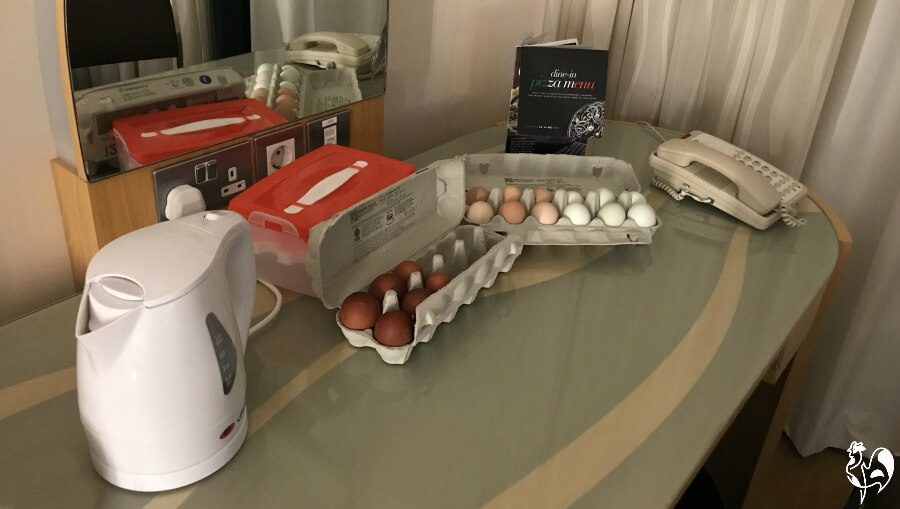 Packing eggs at my London hotel. Egg cartons are not strong enough to withstand a plane journey.
Packing eggs at my London hotel. Egg cartons are not strong enough to withstand a plane journey.Packing.
One of the biggest issues with eggs sent by mail or by air is detached air cells. Jolting in transit can lead to the membrane detaching and "floating" which considerably reduces the chances of a successful hatch. You'll be able to see this during the candling process.
Cardboard egg cartons are simply not strong enough. Eggs are likely to be jolted and potentially cracked.
So make sure your eggs are well packed in a sturdy box. I have used this "double decker" box for years and it's still going strong. I highly recommend it for carrying any eggs.
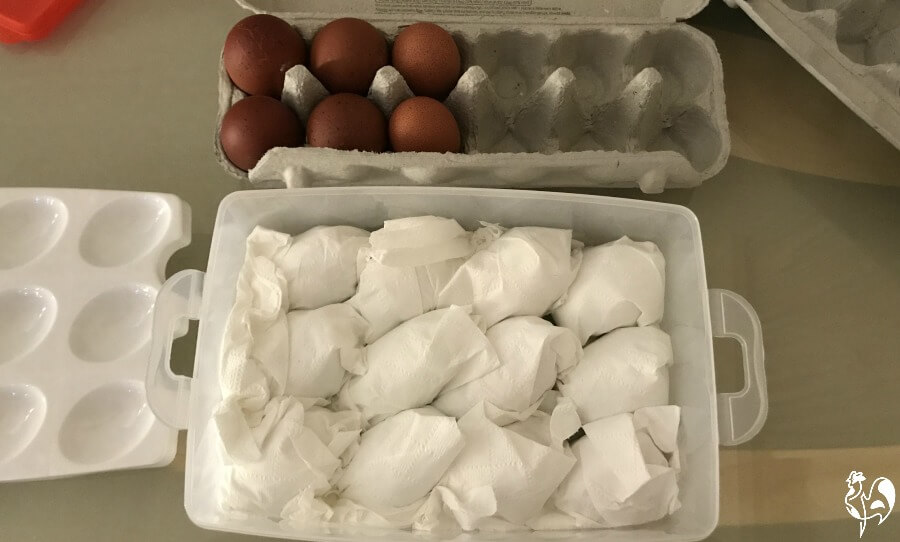 Some of my eggs being packed for a journey by air from the UK to Italy.
Some of my eggs being packed for a journey by air from the UK to Italy.(This is an "affiliate link", which means that if you click and buy something, I earn a small commission at no extra cost to you).
- Make sure the eggs won't move about during the journey by packing each one in something like tissue paper or toilet tissue.
- All the material you use to pack should be new, clean and dry. It must not have come into contact with other birds, especially wild birds.
- If your container stores the eggs in an upright position, make sure the pointed end of the egg is facing downwards, the more blunt end on top.
- And finally, make sure the container is properly closed before you place it inside your carry-on bag.
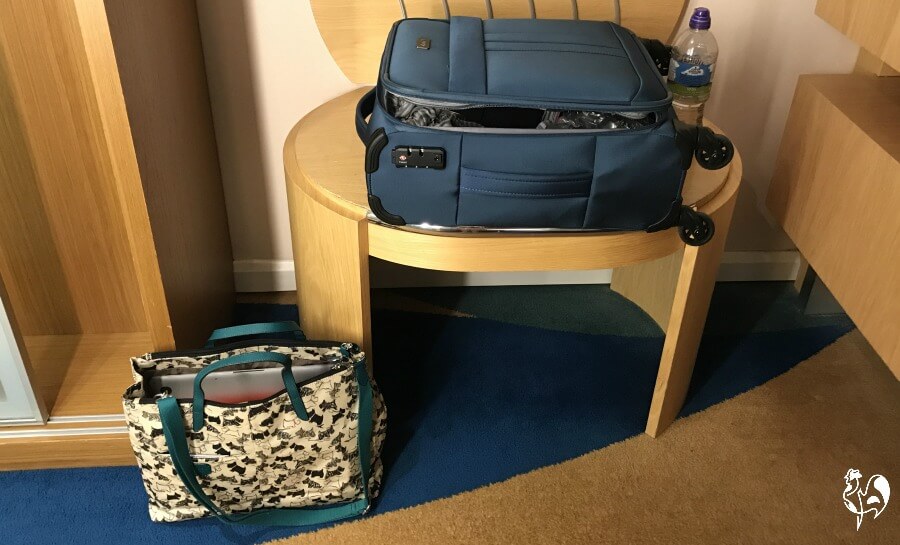 My eggs, packed in my carry-on luggage and waiting to leave the hotel.
My eggs, packed in my carry-on luggage and waiting to leave the hotel.Manage temperature.
Fertile chicken eggs are very susceptible to changes in temperature. As far as possible, it's important to control the temperatures throughout their journey.
- At the hotel, use air conditioning to keep the temperature around 14º - 18º Centigrade (55º - 65º F). Much higher than that and there's a danger the eggs will start to incubate.
- Temperatures lower than 7ºC (45º F) are known to result in higher than usual embryo deaths.
Step 3: manage the airport.
Always carry fertile eggs as hand luggage.
Packing them in your stowed luggage means you won't be able to control either the handling or the temperature.
Some airports have special "animal lounges" which are lower in temperature than the public areas. If the airport you're flying from has one – use it.
Otherwise, find a space which is as cool as possible.
When boarding the plane, try to make sure you're near the front of the queue so that you spend as little time as possible standing on the runway waiting for other passengers to climb the steps.
Your aim is to minimise the time you spend in any area where temperatures fluctuate, or where it's raining.
At the airport: scanners.
Surprisingly, eggs do not count as liquids, so they can travel in hand luggage with no problem.
But many people avoid taking hatching eggs by plane because they're concerned that the security scanners will affect the eggs.
Carry-on luggage does have to pass through x-ray scanners at security. It's possible to ask for your luggage to be scanned by hand, although it's not something I've ever done.
I have never experienced a lower hatch rate in eggs carried by plane than eggs transported in any other way.
Certainly, if you would like to transport hatching eggs by air, do not let the thought of scanners put you off.
Step 4: manage the flight.
On the plane, store the eggs under the seat in front of you rather than risk it being jostled by other baggage in the overhead locker.
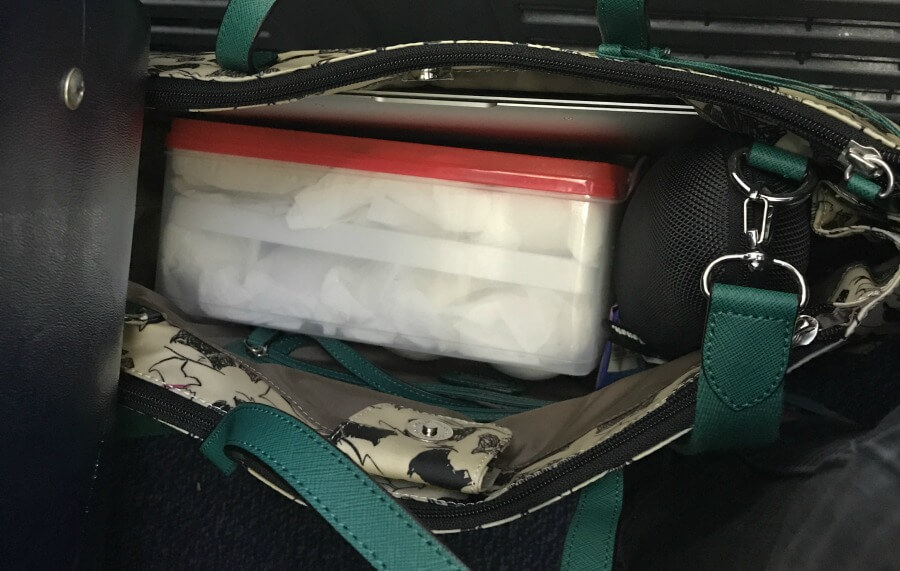 My eggs on the plane, in my hand luggage and placed underneath the seat in front.
My eggs on the plane, in my hand luggage and placed underneath the seat in front.Being able to control the temperature on the plane is another important reason to take your eggs with you into the cabin. The temperature in the cargo area of a plane is much too low for fertile eggs to survive.
Planes are often kept at a very warm temperature. There's a limit to how much you can control the cabin temperature, but you can at least use the air control to keep your area as cool as possible.
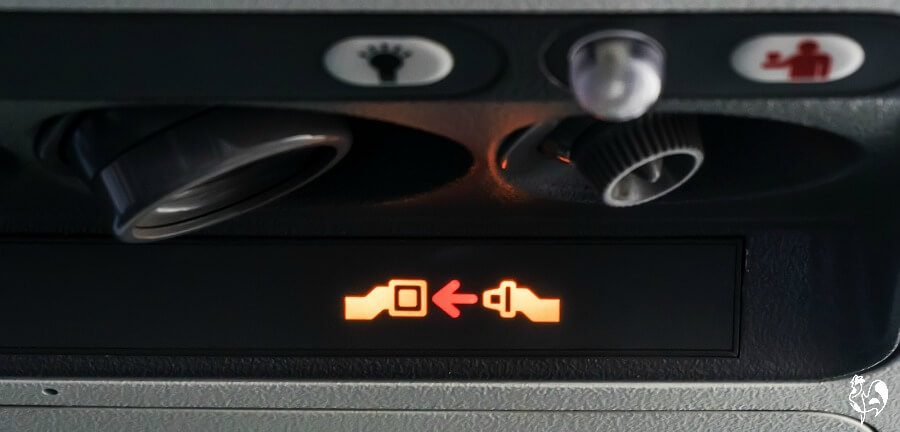 Use the air control above your seat to keep your area as cool as possible.
Use the air control above your seat to keep your area as cool as possible.Once your eggs are safely stowed under your seat and you have done what you can to control the temperature, leave your eggs – and enjoy your journey!
 May, and my eggs fly over the stunning Alps into Italy, at 37,000 feet.
May, and my eggs fly over the stunning Alps into Italy, at 37,000 feet.If you found this article helpful, you may also like these.
Sources.
There is a lot of mis-information on the internet about transporting fertile chicken eggs by air. These are the sources I have used to check the facts.
It is always wise to check with your airline, and / or with the security section of the airport from which you'll be flying, to make sure they are standing by the legal regulations.
1. Fresh Eggs. Pub. Transportation Security Administration.
2. Procedures for Importing Poultry Hatching Eggs into the United States. Pub. US Department of Agriculture, 2018.
3. Exportation of Live Animals, Hatching Eggs, and Animal Germplasm from the United States. Pub. USDA, 2019.
4. Moving live animals or animal products. Pub. gov.uk, 2014, updated 2019.
5. EU import conditions for poultry and poultry products. Pub. European Commission, 2011, updated 2019.
6. Hand luggage restrictions at UK airports. Pub. gov.uk, 2019.
7. European Guide to Good Air Transport of Hatching Eggs and Day Old Chicks. Pub. Association of European Poultry Breeders, 2011.
8. How does an airport scanner work? Pub. Science Focus, 2019.
- Home
- Before you incubate
- Transporting eggs














